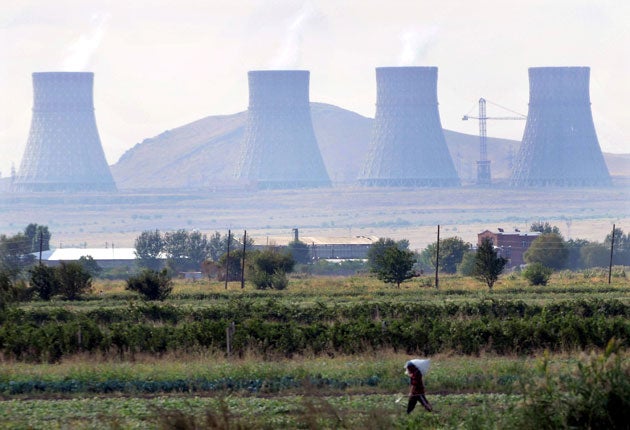More than one in 10 nuclear power plants at risk from earthquakes
Many stations are in countries that would be less able than Japan to cope with disasters

Scores of nuclear power plants worldwide are at risk from tsunamis or earthquakes similar to the natural disasters that crippled Japan's Fukushima reactors, according to new research. Many at-risk plants are in countries less able to cope with a disaster than Japan, experts have warned.
Seventy-six operating power stations in Japan, Taiwan, China, South Korea, India, Pakistan and the US are located in areas close to coastlines deemed vulnerable to tsunamis.
Of 442 nuclear power stations globally, more than one in 10are situated in places deemed to be at high or extreme risk of earthquakes – in Japan, the US, Taiwan, Armenia and Slovenia – according to a new study by the analysts Maplecroft.
Helen Hodge, Maplecroft's natural hazards analyst, said: "Although Japanese nuclear facilities are particularly exposed, other countries could also face similar risks. South Korea, Taiwan, southern China, India, Pakistan and the west coast of the US have operating or planned nuclear facilities on tsunami-exposed coastlines, while nuclear sites in areas of high or extreme risk of earthquakes can be found in western US, Taiwan, Armenia, Iran and Slovenia."
Emeritus Professor Keith Barnham, a physicist from Imperial College London, commented: "Japan is one of the most advanced technological counties but one can see the problems they are having in coping with the aftermath. One fears for the reactors planned or operational in the environmentally unsafe areas of less technologically developed countries."
Nuclear safety experts cite the example of an ageing Russian-built nuclear reactor only 30km from the Armenian capital, Yerevan. In December 1988, a powerful earthquake, which led to the deaths of at least 25,000 people, occurred in north-west Armenia. The following year, the Metsamor nuclear plant was shut down due to safety concerns regarding "seismic vulnerability". Although one of its reactors is now being decommissioned, another remains operational. The International Atomic Energy Association (IAEA) has been involved in safety improvements at the plant for more than a decade.
But, according to the World Nuclear Association, "The present Metsamor plant is a concern to the European Union and to neighbouring Turkey, 16km away. There have been various calls to shut it down ... but Armenia is very dependent on it and has said that it will remain open until a replacement is commissioned."
The risks of future natural disasters have been recognised by the IAEA in recent years, which set up the International Seismic Safety Centre in 2008. Its safety guidelines on earthquakes and tsunamis are being revised following the incident at Japan's Fukushima Daiichi nuclear plant.
The Japanese crisis has reignited the debate over nuclear safety. As a result, several nations, including Italy, Switzerland and Germany, have put new reactor plans on hold. The nuclear plant at Fukushimi was crippled after an earthquake and tsunami devastated north-east Japan last month.
James Acton, nuclear expert at the Carnegie Endowment for International Peace, commented: "The key question is whether we have correctly predicted the risk that a reactor could be hit by a disaster (natural or man-made) that is bigger than it is designed to withstand. This issue should be urgently reviewed by all states with reactors."
Jeremy Gordon, editor of World Nuclear News, predicted there would be a "step change" in efforts to improve safety. "While it's true that many, if not most countries, would be less prepared than Japan to face an unprecedented natural disaster and nuclear accident on this scale," he said, "the country involved in future would likely have a far better practical support network from other governments and practical experts in industry."
Dr Gordon Woo, an IAEA consultant, said there was already a "significant degree" of seismic technology transfer by the IAEA to less advanced nations. He predicted this would increase after the Japanese disaster.
Join our commenting forum
Join thought-provoking conversations, follow other Independent readers and see their replies
Comments